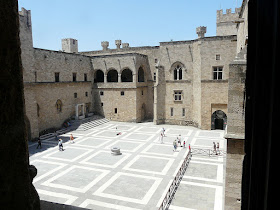As it happens, I was holidaying on the island of Rhodes this summer, so I course, I had to visit the Palace of the Grand Master in Rhodes Old Town. It was the second time I had been there but it was still a shock to be reminded just how big it is and how massive its walls.
 |
| Credit: Bernard Gagnon, Creative Commons |
Much as I love castles, there is a line which is easily crossed into Disneyfication and what Eugène Viollet-le-Duc did to Carcassonne in the mid nineteenth century teeters awkwardly on it. But Vittorio Mesturini, the Italian architect who worked on the Palace of the Grand Master, didn't go too far.
 |
| Credit: Sailko, Creative Commons |
Five hundred years after it was built, the Knights Hospitaller took over Rhodes and some other Greek Islands and wasn't long before they decided that the citadel of Rhodes would make an ideal headquarters (and who could blame them?).
 |
| Photo: author's own |
It's built on the highest point of the island's north west region and makes an excellent fortified fastness. Then, as now, the area south of the citadel and between it and the outer walls was full of winding, narrow streets, where goods of all kind were sold. There were also gardens, workshops, warehouses, taverns and a market square. Orthodox and Catholic churches were scattered throughout the town.
The Knights Hospitallers captured the island in 1309 and remained in charge till Rhodes fell to the Ottomans (Turks) in 1522. They were the knights of Saint John of Jerusalem. They were the seemingly oxymoronic "religious-military Order" that had been going for about two hundred years before they became dominant in the Dodecanese.
It seems to have been founded by a man called Pierre Gerard in Jerusalem and named for John the Baptist. At the beginning, they were just Hospitallers and it was his successor, Raymond de Puys, who organised it into a miitary body. (They are not to be confused with the Knights Templar, beloved of Dan Brown and his followers - 377K of them on Twitter).
The Order was divided into three: knights, who were nobles; chaplains, who were priests and sergeants, who were the sons of free men. Grand Masters were always chosen from among the knights; he held the post for life.
 |
| Credit: Piotrus, Creative Commons |
The vast palace is arranged in a rectangle around a courtyard. Then were ten silos of grain sunk into the courtyard. Three are left, with well heads on top of them. The upper storey of the building bears no relation to anything that was there before 1937. This is what the Great Hall looks like inside Now:
 |
| Credit: Szilas, Creative Commons |
And this is one of the fabulous mosaic floors, with the head of the Medusa, from Kos:
 |
| Credit: Wimpearl, Creative Commons |
And a lovely leopard:
 |
| Credit: Sailko, Creative Commons |
Do tell us your favourite castle or palace in the Comments.

I came to this post late, Mary, but I remember staying on Rhodes in the '70s, visiting Rhodes Town and being just as impressed as you were by the Palace of the Grand Master. I remember being slightly disappointed to discover that it had been extensively restored by Mussolini but it does show us just how grand and extensive these structures were when too often all that remains for us to see now are ruins. It also underlines the enormous wealth of Orders like the Knights Hospitillars who could afford to build so monumentally.
ReplyDeleteA super post, Mary. Alas, i was only 2 when I lived in Rhodes so don't remember this at all. On a subsequent visit the only thing I can recall is valley full of butterflies! I love castles and spent a lot of my childhood passing Cardiff Castle on the bus....on the way to my aunt's house....
ReplyDelete